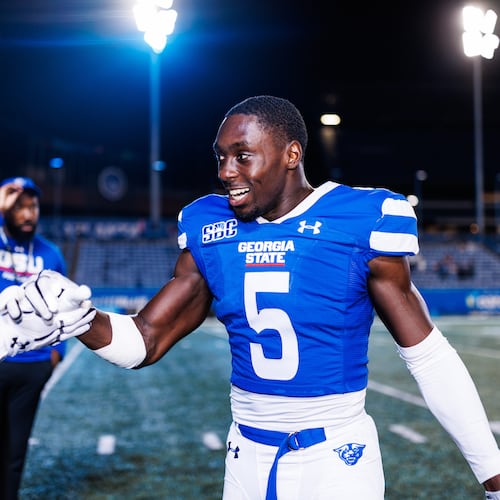This past Saturday, the same Georgia Tech defense that sometimes failed to fill in gaps in the run game, had trouble with North Carolina’s up-tempo pace and gave up a season-long run of 46 yards.
However, it also made two game-changing interceptions in the fourth quarter, set a season high for tackles for loss (seven), recorded six quarterback hurries (second most this season) and held North Carolina’s offense in the first half to a field goal.
And won.
In defensive coordinator Nate Woody’s first season, the signs of progress are visible through nine games, particularly in the connected areas of pressure on the quarterback and turnovers created. But, there’s also signs of a defense still learning a new system of play and that lacks experience in the secondary.
“I think you’d always like to be more consistent,” coach Paul Johnson said Tuesday of the defense. “But when you do something new, that’s probably kind of what happens.”
Some numbers tell the story of a unit that is defending at a level near or even below last year’s as it prepares to play Miami on Saturday at Bobby Dodd Stadium. Tech is giving up 5.7 yards per play after giving up 5.5 last season. The defense is ranked 95th in defensive efficiency (Football Outsiders) after finishing last season 69th. Tech opponents are converting 48 percent of third downs, compared to 31 percent last season.
“Sometimes it seems like we’re better on third-and-3 than we are on third-and-13,” Johnson said. “I think that probably anytime you put something new in, the run fits probably come a little easier than the back end, and we have new guys in the back end.”
The most obvious improvement is in the Jackets’ ability to manufacture turnovers. Tech has 20 takeaways, tied for eighth nationally, after producing 10 last season and 19 in 2016.
Also, while Tech’s 1.4 sacks per game are close to last year’s rate of 1.5, the Jackets have also been credited with 2.8 quarterback hurries per game, compared to 2.0 last season. Woody’s scheme and play calls have enabled ends Anree Saint-Amour and Desmond Branch to pressure quarterbacks with greater regularity.
“If you go back and look, I think Nate’s had a pretty good history for creating some turnovers with what they do,” Johnson said. “So I certainly don’t want to diminish that. But at the same time, I can promise you we’re not doing anything in practice that we didn’t do before. I think it can be a function of maybe we get a little more pressure.”
Woody’s defense has also improved on one shortcoming of former coordinator Ted Roof’s defense that drove Johnson batty - giving up scores to end halves. The Jackets have given up two scores (one touchdown and one field goal) on opponents’ final first-half possessions of their nine games. At the ends of second halves, Tech has given up one score of consequence (against USF). Many games have ended in routs.
The Jackets’ two fourth-quarter interceptions against North Carolina were particularly significant in that Tech did not often create stops like that last season and previous years.
But, as Johnson noted, consistency has been an issue. Against North Carolina, the Jackets defense gave up three points in the first half – UNC also scored a defensive touchdown – then surrendered touchdowns on three consecutive drives before closing out with the two interceptions. Against Virginia Tech, the Jackets gave up touchdowns on the three opening drives, but the Hokies didn’t score again until their final possession when the game was out of reach.
“It took some time to get used to it, but I think we’re settling in,” said outside linebacker Jalen Johnson, whose own transition included a move from safety. “I think we’re getting better each week for sure.”
Paul Johnson gave an example from a third-down play on the first series of the North Carolina game. A player was supposed to drop into coverage but instead rushed the passer, a mistake that enabled a conversion. It's a mistake that's less and less likely as players' understanding of the defense deepens. When Woody was at Appalachian State, his defense took its elite shape after a season and a half of play.
“In order to play a complete game, we’re just going to have to focus on what we’re bad at, as much as we don’t like it,” inside linebacker Brant Mitchell said. “We’d all love to sit here and say we’re the best in the country, but we’re not, and we’ve got things to work on, and that’s exactly what we’ve been doing.”
About the Author
Keep Reading
The Latest
Featured


